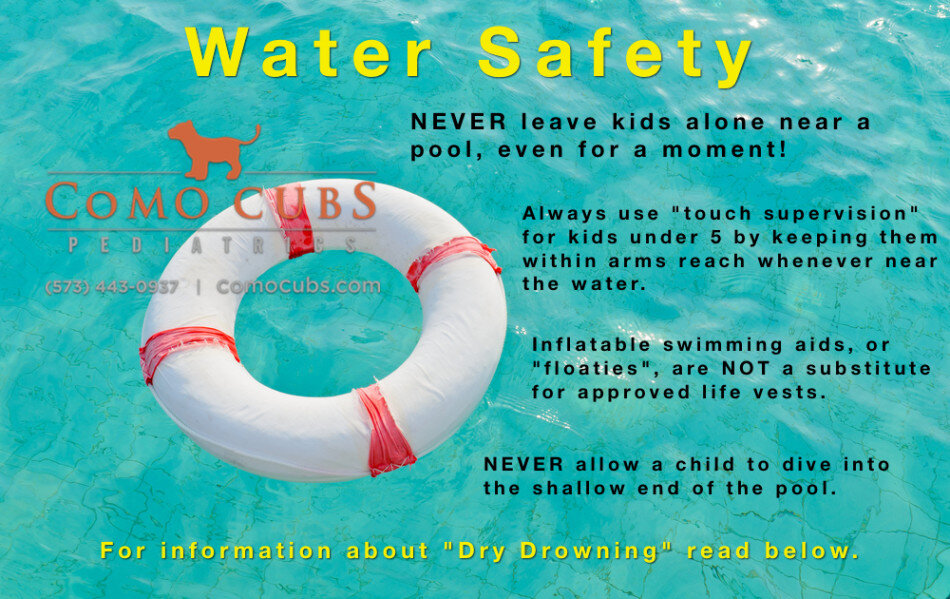Water Safety and "Dry Drowning"

- By Dr. WilsonDrowning is a leading cause of death among children, including infants and toddlers. Most infant drownings occur in bathtubs and buckets. Toddlers between one and four years most commonly drown in swimming pools. However, many children in this age group drown in ponds, rivers, and lakes. Children older than five years old are most likely to drown in rivers and lakes, but It is important to know that children can drown in even one inch of water.
Pool Safety
- Never leave children alone in or near the pool or spa, even for a moment; close supervision by a responsible adult is the best way to prevent drowning in children.
- Whenever children under age 5 are in or around water, an adult – preferably one who knows how to swim and perform CPR – should be within arm's length, providing "touch supervision."
- Install a fence at least 4 feet high around all four sides of the pool. The fence should not have openings or protrusions that a young child could use to get over, under, or through.
- Make sure pool gates open out from the pool, and self-close and self-latch at a height children cannot reach.
- Keep rescue equipment (a shepherd's hook – a long pole with a hook on the end — and life preserver) and a portable telephone near the pool. Choose a shepherd's hook and other rescue equipment made of fiberglass or other materials that do not conduct electricity.
- Avoid inflatable swimming aids such as "floaties." They are not a substitute for approved life vests and can give children and parents a false sense of security.
- Children over age 1 may be at a lower risk of drowning if they have had some formal swimming instruction. However, there is no evidence that swimming lessons or water survival skills courses can prevent drowning in babies younger than 1 year of age.
- The decision to enroll a child over age one in swimming lessons should be made by the parent based on the child's developmental readiness and exposure to water, but swim programs should never be seen as "drown proofing" a child of any age.
- Large, inflatable, above-ground pools have become increasingly popular for backyard use. Children may fall in if they lean against the soft side of an inflatable pool. Although such pools are often exempt from local pool fencing requirements, it is essential that they be surrounded by an appropriate fence just as a permanent pool would be so that children cannot gain unsupervised access.
- If a child is missing, look for him or her in the pool or spa first.
What is "Dry Drowning?"
- excerpted from an excellent article by Dr. Kathleen Berchelmann,MD. See the full article here.
Dry drowning scares me. The kids can look fine– they just had a little sputtering and coughing episode after a scary moment while swimming. Occasionally dry drowning can happen in the bathtub. But sometime within the next 24 hours their lungs start a massive inflammatory reaction to the water they inhaled into their lungs. Sometimes they need a ventilator to breathe for them, and drugs to keep their blood pressure up. But the worst cases of dry drowning are the children I never see, the ones who were put to bed and never wake up in the morning.
There is some debate about the definition of the term "dry drowning"– usually this term refers to situations where some water got in a child's lungs and the child has a severe inflammatory reaction to the water hours after the incident. This phenomenon is also called "secondary drowning," or "near drowning."
Warning Signs & Symptoms of Dry or Delayed Drowning
What are the warning signs and symptoms of "dry" or delayed drowning? When do parents have to worry about a child who had trouble while swimming?
These are reasons to bring your child to the emergency room, even if they look fine:
- Coughing: Any person who has persistent coughing after playing in the water is at risk for water in their lungs. You may be thinking, "But this happened to me a million times when I was a kid." But what was your oxygen level while you were sleeping that night? You may have dropped and no one ever knew. Don't go to bed worrying, just take your child in for evaluation.
- Water rescue: Any person who was submerged in water and came up struggling, especially if he or she had to be retrieved from the water by a lifeguard, parent, or other bystander needs medical evaluation. This may seem obvious, but I've seen kids get back in the pool and play after a water rescue.
- Amnesia: Any person who was unconscious underwater or has limited memory of an incident that occurred in water needs immediate medical care. I had a patient once who had an underwater head injury with loss of consciousness, but finished her swim meet before going to the ER. I'm just thankful she didn't drown or bleed into her brain during that second race.
- Behavior change: If your child feels sick, acts too sleepy, or has a change in mental status/behavior after a day at the pool, take it seriously. The worst thing you can do with a child who may have inhaled water is put them to bed. They need immediate medical care.
- Vomiting: Vomiting after a day of swimming can be due to waterborne infectious disease (poop in the pool water…), but can also be a sign of severe illness due to dry drowning.
As always, if you are worried or have questions, please give us a call!
